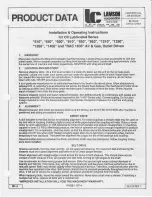
Not for
Reproduction
3
Adding Fuel
Fuel must meet these requirements:
• Clean, fresh, unleaded gasoline
• A minimum of 87 octane / 87 AKI (90 RON)
• Up to 10% ethanol is acceptable
NOTICE
Do not use unapproved gasolines, such as E15 and E85. Do
not mix oil in gasoline or modify the engine to run on alternate
fuels. Use of unapproved fuels will cause engine damage that
will not be covered under warranty.
This engine is certified to operate on gasoline. The emissions
control system for this engine is EM (Engine Modifications).
At altitudes over 5,000 feet (1524 meters), a minimum 85 octane
/ 85 AKI (89 RON) gasoline is acceptable. To remain emissions
compliant, high altitude adjustment is required. Operation without
this adjustment will cause decreased performance, increased
fuel consumption, and increased emissions. See an authorized
service dealer for high altitude adjustment information. Operation
altitudes below 2,500 feet (762 meters) with the high altitude
adjustment is not recommended.
WARNING
Fuel and its vapors are extremely flammable and explosive.
Always handle fuel with extreme care.
Failure to observe these safety instructions can cause a fire
or explosion which could result in serve burns or death.
• Do not add fuel while engine is running. Let the engine
cool at least 2 minutes before adding fuel.
• Fill the fuel tank outdoors only, using an approved fuel
container with the unit directly on the ground.
• Keep fuel away from sparks, open flames, pilot lights,
heat, and other ignition sources.
• Allow any spilled fuel to evaporate before starting the
engine.
• If fuel is spilled on clothing change clothing immediately.
1.
Slowly remove the fuel cap (A, Figure 4) and fill the tank
(B) with fuel. Do not fill higher than the bottom of the fuel
tank neck (C).
2.
Reinstall the fuel cap. Allow any spilled fuel to evaporate
before starting the engine.
4
7








































